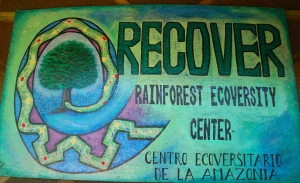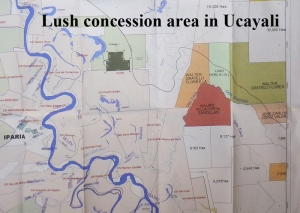By Campbell Plowden
See: The rosewood project in Peru – Part 1: Progress in the Ampiyacu

Recover – Rainforest Ecoversity Center. Photo by Campbell Plowden/Center for Amazon Community Ecology
Near the end of our six weeks in Peru, my son Luke and I took a one hour flight from Iquitos to Pucallpa to investigate another rosewood oil project. This trip would have taken us five days to chug up the Ucayali River by lancha (ferry boat) since no roads link Iquitos to the outside world. I arrived in the city with a few disparate contacts, but a series of meetings led to me Limber Gongora – director of Recover (Rainforest Ecoversity Center).

Rosewood seedling under canopy at RECOVER. Photo by Campbell Plowden/Center for Amazon Community Ecology
Recover is a non-profit organization that does environmental education and rainforest restoration projects at its center just outside the city. When Luke and I toured the center we saw that each of the rosewood seedlings they had planted were shaded under a thatched shelter to prevent the sun from baking them. I was surprised to see that several years after planting, most of the seedlings were still only a foot or two tall. I’d heard that rosewood is not a pioneer species that grows rapidly in open sun, but I wondered if this growth rate was unusually slow due to the reduced fertility or increased compaction of the soil that was last used for cattle grazing.
Apart from his work with Recover, Limber is also working with the Lush Cosmetics company based in the United Kingdom to produce rosewood for export. While surveying forest lands belong to a Shipibo community, they discovered that the forest in a logging concession actually had more of this aromatic tree that had been wiped out in most of its former range. Lush ultimately took over the harvesting rights in this area and backed the purchase of an 85 gallon distiller from Heart Magic to process leaves, branches and wood from trees that were already on the ground.

Palo Rosa sign with Shipibo and scientific name at Recover center. Photo by Campbell Plowden/Center for Amazon Community Ecology
One valuable tip I picked up from Limber was that they had created their own version of a “rocket” (energy efficient) stove that allowed them to heat the still for a full run with a few pieces of fuel wood instead of having to buy and cart in an endless series of expensive tanks of gas. I wished I could have seen their operation, but it was too deep in the forest to reach with my limited time.
The Lush operation in Peru was getting a decent yield of oil, and they had already produced their first barrel. The company had not been able to ship it out yet, though, because they were still trying to sort out export regulations with the Peruvian government. The species is rightfully listed as a protected species with the Conventional on International Trades in Endangered Species (CITES) so procedures need to be adopted to demonstrate that making and selling this oil is being done in a sustainable way that does not aggravate the threatened status of this tree.

Campbell Plowden with FECONAU leaders Robert Guimaraes and Felipe Mori Guimaraes in Pucallpa. Photo by Center for Amazon Community Ecology

Shipibo artisan Esther Lopez Chavez with hand-made fabric. Photo by Campbell Plowden/Center for Amazon Community Ecology
During my stay in Pucallpa, I also met with two leaders from FECANAU (the federation that represents 33 Shipibo native communities in the Pucallpa region) and learned about their forest inventory activities in the Flor de Ucayali community and the group’s desire to develop their own operation to distill and sell rosewood and other aromatic oils. They seemed like good potential partners, but CACE does not yet have the resources to develop a new essential oil project beyond our current ones in Loreto. I did visit one Shipibo community, however, and bought a few of the beautiful hand-made Shipibo fabrics that CACE will try to sell on a limited basis.
My final stop in Pucallpa to learn about the management of rosewood was the IIAP (Institute for Investigations of the Peruvian Amazon) office on the outskirts of the city. The director welcomed me and brought me to the office of the man responsible for silvicultural research. He looked through his collection of thick reports on various trees, but they were none focused on rosewood. We then toured the nursery where hundreds to thousands of cuttings of several timber species were being cultivated in protected bins to study their genetic and growth characteristics.

Palo Rosa sign at IIAP herbarium in Pucallpa. Photo by Campbell Plowden/Center for Amazon Community Ecology
The only rosewood seedlings around were a handful of survivors of two rows planted in 2009 that an almost blank sign indicated came from Tamshiyacu. The researcher assured me that IIAP would be very happy to initiate a proper set of trials at their nursery if we wished to pay for it. His remarks were a potent reminder that the government invests few of its own resources into developing non-timber forest resources. The burden for doing such studies rests almost entirely with non-governmental groups who wish to develop these options for communities.
CACE now plans to purchase a Patriot grinder to shred small branches and leaves from rosewood and other aromatic trees in the Ampiyacu and other project sites into small chips. We will then feed these into a 20 gallon distiller we plan to buy from Heart Magic to extract what we hope will be beautifully scented oils that can be sold for use in perfume and/or aromatherapy. We will continue to share notes with Camino Verde that has purchased the same equipment and has already produced a trial batch of oil from a rosewood tree relative and aims to produce rosewood oil in the future when seedlings it has planted reach an adequate size to be pruned in a few years.
We have raised enough funds now to purchase the grinder and distiller in the U.S. which are not available in Peru. We now need to raise another $4000 to design and build our own “rocket stove” and pay for shipping and customs fees to get this equipment to our base in Iquitos. Learn more about this project and how you can support it at: http://www.AmazonAlive.net and http://www.AmazonEcology.org.
See: The rosewood project in Peru – Part 1: Progress in the Ampiyacu





